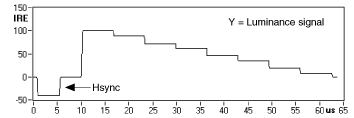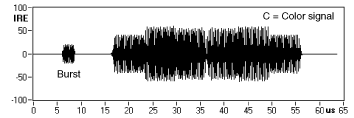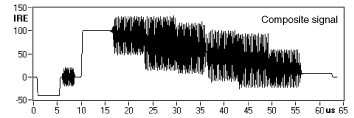Video Fundamentals
Generating Composite Video Signals
A composite video signal is a signal in which all the components needed to generate a video signal are embedded in a single signal. The three main components that together form a composite signal are as follows:
- The luma signal (or luminance)—Contains the intensity (brightness or darkness) information of the video image
- The chroma signal—Contains the color information of the video image
- The synchronization signal—Controls the scanning of the signal on a display such as the TV screen
The monochrome composite signal is built of two components: luma and synchronization. The luma signal, which is usually called the Y signal, is shown in the following figure.

Monochrome Composite Video Signal (Luma Steps from White to Black)
The chroma signal by itself, which is usually called the C signal, is shown in the following figure.

Color Information Signal for a Color Bar Line (Including the Color Burst)
The composite color video signal, often called the Color Video, Blank, and Sync (CVBS) signal, is the sum of Y and C.
CVBS = Y + C

Color Composite Video Signal for a Color Bar Line
The two components Y and C can also be distributed separately as two independent signals. These two signals together are called either Y/C or S-video.
Y/C = S-video